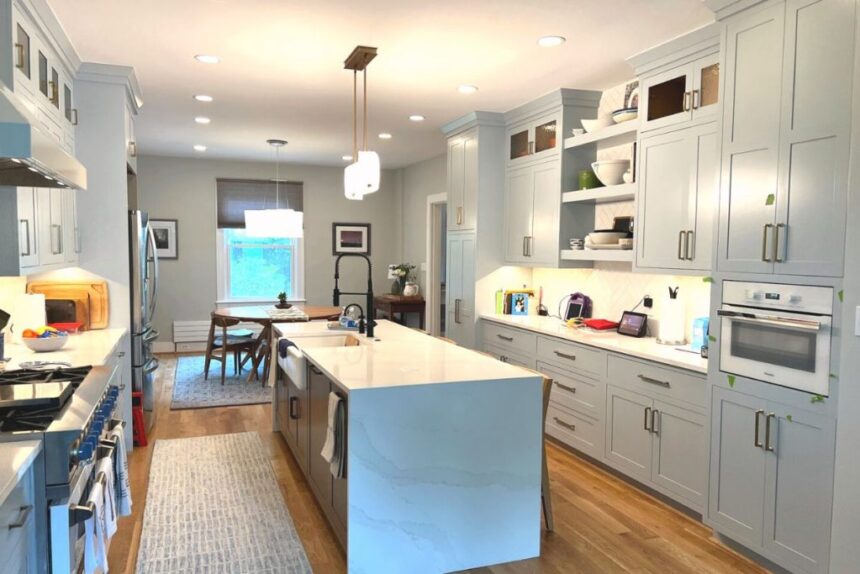Key Takeaways
- Kitchen remodeling can significantly enhance your home’s functionality and aesthetic appeal.
- Understanding the latest trends can guide your remodeling decisions.
- A well-planned remodel balances style, function, and sustainability.
- Consider diverse design elements like lighting, cabinetry, and flooring to personalize your space.
Why Remodel? Enhancing Home Value and Comfort
There’s more to a kitchen refresh than meets the eye. From maximizing function to increasing your property’s value, kitchen remodeling is a comprehensive investment that impacts your daily experiences and long-term financial health. For homeowners looking to sell, a well-executed remodel can significantly boost market appeal, often making homes more attractive to potential buyers. According to a real estate study, remodeled kitchens can recoup up to 75-100% of their costs when the property is sold. This makes a kitchen remodel a rejuvenation of your living space and a strategic financial decision.
Trending Styles in Kitchen Design
Kitchen design trends evolve with changing tastes and technology, reflecting broader shifts towards minimalism and functionality. Current trends include open shelving, which offers a practical yet stylish solution for showcasing kitchenware and decorative items while creating a sense of space and openness. Minimalist color palettes, focusing on neutral tones like whites, grays, and beiges, serve to create clean, serene environments that allow individual design elements to stand out. Many homeowners are also incorporating natural materials like wood and stone, which add warmth and texture to the space. These trends, detailed on design-focused resources, allow you to creatively blend contemporary style with personalized touches, making your kitchen uniquely yours.
Planning Your Kitchen Remodel
Embarking on a kitchen remodel necessitates meticulous planning and thoughtful decision-making. Start by establishing a clear budget, which serves as the foundation for your remodel’s scope and feasibility. This involves prioritizing key areas and anticipating costs, from materials and labor to unforeseen expenses. Creating a timeline is crucial, helping you navigate each phase of the process—from design and demolition to construction and final touches. The significance of selecting the right contractor cannot be overstated; leverage word-of-mouth recommendations and online reviews to ensure that you’re partnering with reliable professionals who share your vision and standards.
Choosing the Right Materials
The materials you choose for your kitchen greatly impact both its aesthetic and functional qualities. Countertops are available in a variety of materials, such as granite, which is favored for its durability and timeless appeal, while quartz offers a non-porous surface that’s easy to maintain. For cabinetry, solid wood provides a classic look but requires more care, whereas MDF (Medium Density Fiberboard) offers a cost-effective alternative with a smooth finish. When selecting flooring, it’s vital to balance resilience with style; options like ceramic tiles and hardwood offer longevity and diverse design possibilities. Every material choice contributes to the overall harmony and usability of your kitchen, aligning with your lifestyle needs.
The Importance of Lighting
Lighting is a fundamental element in kitchen design, enhancing both functionality and ambiance. A well-lit kitchen combines various lighting types to create a dynamic, inviting atmosphere. Ambient lighting acts as the primary source, ensuring overall illumination. Task lighting, such as under-cabinet fixtures, is essential for highlighting workspaces like countertops and stovetops. Accent lighting, meanwhile, is perfect for spotlighting architectural and design features, adding depth and interest to the room. Energy-efficient lighting options like LED not only brighten your kitchen effectively but also reduce energy consumption, supporting sustainable living goals.
Incorporating Smart Technology
As technology progresses, the integration of smart solutions into kitchen spaces has become increasingly commonplace. Smart technology offers convenience and innovation, making daily tasks more efficient and enjoyable. Smart refrigerators track inventory, suggest recipes, and even stream music, while sensor-equipped faucets provide water without touch. Voice-controlled systems can operate lighting and appliances, offering seamless interaction with your kitchen. Embracing smart technology can transform your kitchen into an intuitive, interconnected space that enhances daily routines and supports modern lifestyles.
Sustainable Choices for a Green Kitchen
Environmental considerations are becoming a top priority during remodels, with many homeowners seeking to minimize their ecological footprint. When selecting materials, opt for eco-friendly options like recycled glass or sustainably sourced bamboo for countertops and cabinetry. Installing energy-efficient appliances not only conserves resources but also reduces monthly utility bills—a win for both the planet and your wallet. Sustainable choices benefit the planet and contribute to healthier indoor air quality and a more ethical living space.
Bringing It All Together
The journey of a kitchen remodel culminates in a personalized, functional, and stylish space that reflects your unique tastes and practical needs. Combining trending styles, thoughtful material choices, innovative technologies, and sustainable practices results in a kitchen that’s not only visually attractive but also boosts the overall functionality of your home. Whether you’re inspired by modern minimalism or traditional warmth, the key is to ensure that your kitchen aligns with your lifestyle and supports a welcoming, efficient environment for years to come.






